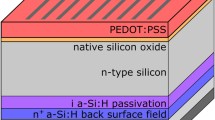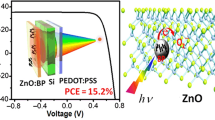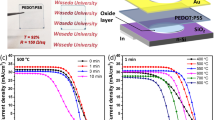Abstract
Hybrid organic/silicon heterostructures have become of great interest for photovoltaic application due to their promising features (e.g. easy fabrication in a low-temperature process) for cost-effective photovoltaics. This work is focused on solar cells with a hybrid heterojunction between the polymer poly(3-hexylthiophene-2,5-diyl) (P3HT) and n-doped monocrystalline silicon. As semi-transparent top contact, a thin (15 nm) Au layer was employed. Devices with different P3HT thicknesses were processed by spin-casting and compared with a reference Au/n-Si Schottky diode solar cell.
The current density-voltage (J-V) measurements of the hybrid devices show a significant increase in open-circuit voltage (VOC) from 0.29 V up to 0.50 V for the best performing hybrid devices compared to the Schottky diode reference, while the short-circuit current density (JSC) does not change significantly. The increased VOC indicates that P3HT effectively reduces the reverse electron current into the gold contact. The wavelength-dependent JSC measurements show a decreased JSC in the wavelength range of P3HT absorption. This is related to the reduced JSC generation in silicon not being compensated by JSC generation in P3HT. It is concluded that the charge generation in P3HT is less efficient than in silicon.
After a thermal annealing of the hybrid P3HT/silicon solar cells, we achieved power conversion efficiencies (PCE) (AM1.5 illumination) up to 6.5% with VOC of 0.52 V, JSC of 18.6 mA/cm² and a fill factor (FF) of 67%. This is more than twice the efficiency of the reference Schottky diode.
Similar content being viewed by others
References
S. Rohr, Heliatek consolidates its technology leadership by establishing a new world record for organic solar technology with a cell efficiency of 12%. Press release Heliatek GmbH (2013).
NREL research cell efficiency records, http://www.nrel.gov/ncpv/.
N. Espinosa, M. Hösel, D. Angmo, F.C. Krebs, Energy Environ. Sci. 5, 5117 (2012).
S. Avashti, Crystalline-Silicon/Organic Heterojunctions for Solar Photovoltaics, Disseration (2011).
S. Avasthi, S. Lee, Y.L. Loo, J.C. Sturm, Advanced Materials 23, 5762 (2011).
M. Slawinski, M. Weingarten, S. Axmann, F. Urbain, D. Fahle, M. Heuken, A. Vescan, H. Kalisch, Appl. Phys. Lett. 103, 153305 (2013).
H.B. Michaelson, J. Appl. Phys. 48, 4729 (1977).
P3HT data sheet from Sigma Aldrich
S. Kasap, P. Capper, Springer handbook of electronic and photonic materials, (Springer Science & Business Media, 2007).
G. Li, V. Shrotriya, J. Huang, Y. Yao, T. Moriarty, K. Emery, Y. Yang, Nature Materials 4, 864 - 868 (2005).
J. Zhao, A. Wang, M.A. Green, F. Ferrazza, Appl. Phys. Lett. 73, 1991 (1998).
L.H. Nguyen, H. Hoppe, T. Erb, S. Günes, G. Gobsch, N. S. Sariciftci, Advanced Functional Materials 17, 1071–1078 (2007).
M.T. Dang, L. Hirsch, G. Wantz, Advanced Materials 23, 3597 (2011)
Author information
Authors and Affiliations
Rights and permissions
About this article
Cite this article
Weingarten, M., Zweipfennig, T., Vescan, A. et al. Low-Temperature Processed Hybrid Organic/Silicon Solar Cells with Power Conversion Efficiency up to 6.5%. MRS Online Proceedings Library 1771, 201–206 (2015). https://doi.org/10.1557/opl.2015.650
Published:
Issue Date:
DOI: https://doi.org/10.1557/opl.2015.650




